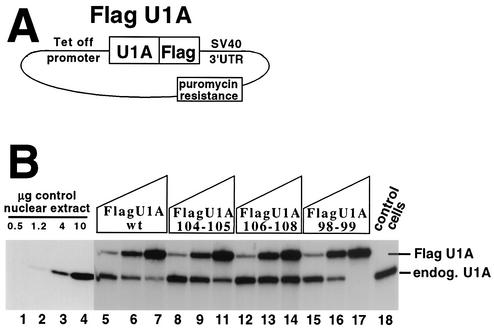FIG. 6.
In vivo inhibitory activity of selected mutant U1A proteins on the expression of endogenous U1A. (A) Schematic of the plasmid harboring FLAG epitope-tagged U1A under the control of a tetracycline (Tet-OFF) promoter used to make puromycin-resistant stable cell lines. Note that the vector does not contain the PIE RNA U1A binding sites and so would not be a target for U1A autoregulation. SV40, simian virus 40. (B) Western blot with an anti-U1A antibody used to measure the inhibitory effect of the tagged U1A proteins on the expression of endogenous (endog.) U1A protein. Lanes 5 to 17 contain 10 μg of nuclear extract from cells stably expressing different amounts of tagged U1A protein, as indicated above the lanes. Lanes 5 to 17 are four sets of three lanes each where each set is from a single stable cell line clone expressing the tagged U1A protein as indicated, where the amount of tagged U1A was controlled by addition of increasing amounts of DOX, an inhibitor of the Tet-OFF promoter. Similar results were obtained by analysis of other stable cell line clones (data not shown). Lanes 1 to 4 and 18 contain material from control cells stably expressing the plasmid shown in panel A that lacks the FLAG-U1A coding region. Lanes 1 to 4 contain different amounts of nuclear extract to gauge the sensitivity of the enhanced-chemiluminescence-based Western blot. Anti-U1A antibody 856 was used in the Western blot as previously described (26). Probing of the same blot with an anti-U2AF65 antibody confirmed equal loading and transfer of the nuclear proteins (data not shown).

